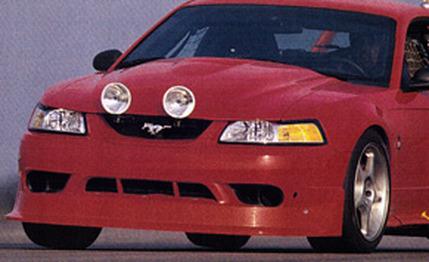
 Road Test
Road Test
"Nice, eh?" asks John Coletti, Ford Special Vehicle Engineering manager, who headed up the team that created the 2000 Ford SVT Mustang Cobra R we're driving on a rural Texas road that is not quite gravel, not quite blacktop.
We're loping along in fourth gear at maybe 50 mph, and the absolute lack of any sort of undercoating or sound deadening in the fender wells to muffle the thrown-up gravel makes it sound as though we're under attack by a battalion armed with Daisy BB guns.
Coletti -- whom you met as the spiritual father of the big-block Mustang that battled the big-block Chevrolet Camaro built by Coletti's approximate bow-tie counterpart, Jon Moss, in our January 2000 cover story -- likes that sound of gravel-in-the-wheel-wells because it suggests one thing: If it doesn't make the car go faster, it probably isn't part of the Cobra R. Sound deadening does not make the car go faster. It is likely Coletti required some engineer to make a case as to whether equipment such as windshield wipers and door locks was really necessary.
It was, he decided. Air conditioning was not. A stereo? Nope. Rear seats? Forget it.
The Cobra R is built to go, turn, and stop fast, evident from the statistics: a 175-mph (drag limited) top speed, a quarter-mile time of 13.2 seconds at 110 mph, 1.02 g of grip on the skidpad, braking from 70 mph to 0 in 160 feet.
Fast cars are expensive, typically, and the Cobra R qualifies there, too: $55,845. SVT will build just 300 for model year 2000, with no present plans for a 2001 model. If your order hasn't already been accepted for delivery, which begins this month to SVT dealers selected through a lottery, most likely you're too late.
The 2000 Cobra R is the third such iteration. The 1993 Cobra R was a tentative, mildly successful step toward a very limited-edition performance Mustang, with just 109 built. Next came 250 copies of the 1995 Cobra R, a more fully realized effort; as tested in the April 1995 issue, our refrigerator-white cover car, with its 300-hp, 5.8-liter pushrod V-8, managed a top speed of 151 mph, quarter-mile performance of 14.0 seconds at 99 mph, 0.89 g on the skidpad, and 70-to-0-mph braking of 165 feet.
Excellent numbers even today. "We have a simple rule of thumb for when it's time to develop a new Cobra R," Coletti says. "First, when there's a need, and second, when the new one will be able to outshine the old one by far." The 2000 model does, at a price about $20,000 more than the 1995 Cobra R.
The exterior of the 2000 Cobra R differs more from the stock Mustang Cobra than the 1995 Cobra R did. The new version has a massive, functional (but nonadjustable) rear wing, a huge front spoiler, and an air splitter that mounts to the car's nose using Dzus fasteners. SVT quietly recommends mounting that splitter only for show or for road-race competition -- the car is delivered with it unattached and wrapped in plastic -- because the first time you get close to a curb you'll wipe out that splitter.
Beneath the body -- painted any color you want as long as it's Performance Red, with a Dark Charcoal interior -- the changes are massive. Inside the cockpit, there are nearly perfect Recaro buckets up front and, as noted, no rear seats. There are dual airbags, a tilting steering wheel, a 180-mph speedometer, and some power-operated features such as outside mirrors, windows, and locks, and a trunk release. The interior is basic, sure, but it doesn't look as bare-bones as you'd expect.
The B&M Ripper shifter connects to a Tremec T-56 six-speed manual transmission. Working our way forward, we find a beefy 11-inch single-disc clutch, an aluminum flywheel, and then the engine: a breathed-on, naturally aspirated 5.4-liter V-8 that pumps out 385 horsepower and 385 pound-feet of torque.
The standard Mustang Cobra has the 5.4-liter Triton's smaller cousin, the 4.6-liter V-8, which is rated at 320 hp. But regular readers may recall our shootout (August 1999) that pitted a 1999 Cobra convertible against a Pontiac Firebird Trans Am and a Camaro SS. We were disappointed in the performance of the Cobra, and when we showed SVT our test results, it did some reconnaissance work and found that some of the Cobra engines departed the factory with less than 320 horsepower, due mostly to an improperly finished intake and too-restrictive mufflers.